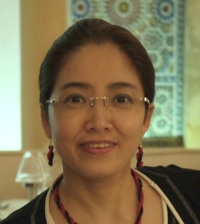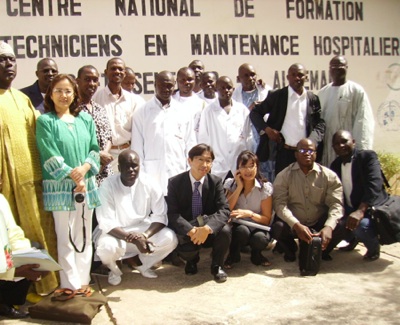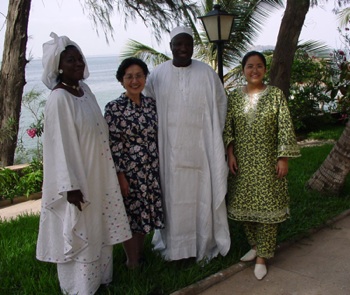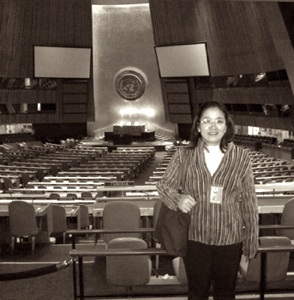 Reiko Hayashi, Japan
Reiko Hayashi, Japan
Director, International Research and Cooperation Department
National Institute of Population and Social Security Research
Ph.D. Program (’07)
Reiko Hayashi obtained a Master of Health Sciences in 1990 and a Bachelor of Technology (Architecture) in 1992 from the University of Tokyo. She also received French Master’s degree from Université de Paris I.
Her doctoral research at GRIPS was on historical global urban population trends. She received her Ph.D. degree in 2007. Her article titled “Long term world population history – A reconstruction from the urban evidence” has received the Excellent Article Award of the Population Association of Japan.
After working at Kimura Structural Engineers, Tokyo, Japan, she set up Linz co. ltd. in 1996, a company dealing with consulting in health care, population, architecture and urban planning, through which she participated in a number of of ODA projects. Among others, she worked as JICA expert in Senegal for the Project for Development of Human Resources in Health in 2002/03, and as Technical Adviser to the Minister of Health and Prevention of Senegal from 2008 to 2011. After working as Assistant Professor in the Center for Sustainable Urban Regeneration at the University of Tokyo, she assumed the position of Director of International Research and Cooperation at National Institute of Population and Social Security Research in April 2012.
Please tell us about your career path thus far. What is your area of specialization and how did you come to work in this area?
I first enrolled in the University of Tokyo in 1984 to study health sciences, especially population studies. After obtaining a Master’s degree from the University of Tokyo as well as the University of Paris, I moved on to study architecture, in 1990. Most people were surprised with my shift, but when you think of hospitals or any medical structure, or urban environmental issues, you can see that studying both fields is relevant.
In 1992, I started working as an architectural structural engineer. This was a great start to gain experience working on several interesting projects and in 1996 I decided to proceed with my original plan to set up my own company. My company is dealing with consulting in health care, population, architecture and urban planning and gradually I got involved in projects such as hospital constructions abroad, financed by Official Development Assistance (ODA). Although my work included projects in countries like Honduras or Indonesia, I started to get more involved in projects in Africa. This was due to the increasing focus of Japanese ODA towards Africa while it was enforced by the fact that I speak French as half of the African countries are francophone.
Then one day I visited one of my old professors from the days I studied architecture at Tokyo University, Professor Fumio Nishino, who then worked at GRIPS. He told me that GRIPS was about to start a Ph.D. program and I got very much interested. Rather than studying health science or architecture as separate disciplines I had always been interested in looking into things from a broader perspective such as human development and how human societies develop and evolve. This is why I enrolled in the Ph.D. program at GRIPS in 2002. Under the supervision of Professor Iwao Fujimasa, my research focused on historical global urban population trends in the past 2000 years. While being a Ph.D. candidate, I continued working, and finally got my Ph.D. in 2007.
During my studies, in 2003, I went for one year to Senegal to work as JICA expert on a project for the development of human resources in health. When I came back, the GRIPS campus had moved from Wakamatsu-cho to Roppongi. Those following years at GRIPS were among the best as it is an amazing environment for doing research, with such a great library and the ability to access all books in university libraries in Japan.
After obtaining my Ph.D., I worked at the University of Tokyo as a COE Researcher in the Center for Sustainable Urban Regeneration for about half a year until moving to Senegal again where I spent three years, until 2011. I was appointed Technical Advisor to the Senegal Minister of Health and was involved in various projects such as construction of health centers, urban hygiene, hospital management and maternal health improvements. I was responsible for the coordination of those projects between the governments of Japan and Senegal.
After returning to Japan, I worked at the University of Tokyo as a Project Assistant Professor in the Center for Sustainable Urban Regeneration for a few months before starting my current job in April 2012 as the Director of International Research and Cooperation Department at the National Institute of Population and Social Security Research.
You are currently working at the National Institute of Population and Social Security Research. Please tell us about the Institute and its mission.
This Institute belongs to the Ministry of Health, Labor & Welfare and is the result of a merger in 1996 of the National Institute of Population Research and the National Institute of Social Security. These institutes both have a long history: 2014 will mark the 75th anniversary of the former National Institute of Population Research and in 2015 we will celebrate the 50th anniversary of the former National Institute of Social Security, and then finally the 20th anniversary of the merged National Institute of Population and Social Security Research in 2016.
The Institute has just around fifty researchers supported by a dozen clerical staff. We do the population projections, both on national scale and more local scales such as prefectures (ToDoFuKen) or cities/villages (ShiChoSon). The Institute is divided into 7 departments, and I am responsible for the International Research and Cooperation Department. We also have five permanent survey units working on the following topics: national fertility, immigration, social security and people’s life, family, and household changes.
Based on the projections and survey results, we conduct researches to help policy makers and those results are widely cited by various parties. Many researchers working here are members of the boards in the concerned subjects. Now one of the main topics we are working is migration and this can be linked to the urbanization issue. Other themes include global aging or innovation/modernization of population statistic institution.
Japan is facing the problem of a rapidly aging population. Do you think Japan will open up more to immigration in the next decade?
Japan already tries to welcome foreigners and the number of immigrants and naturalization is increasing, although the number is modest compared to West European or North American countries. This is partly due to the fact that we do not accept unskilled labor, a policy that is widely supported by broad sections of society in Japan. However, there is an apparent limit due to the fact that we speak mainly Japanese in Japan. Research has shown that immigrants are more bound to go to culturally related countries. The promotion of Japanese language and culture, or strengthening the ties with the sympathizers will be the key. In this sense, the network of GRIPS Alumni has big potential for the future of Japan as well!
At the same time, less students seem to be willing to study abroad, what is your feeling about it?
I have heard about these tendencies, but at the same time I see a lot of young Japanese people who are very motivated to study or work abroad. Contrary to what is said in the media, statistics suggest that only around 3% of Americans or Europeans are out of their countries and this rate is almost the same as Japanese. Also recent figures show that the younger people in Japan have more experiences staying abroad. It is possible that there is polarization of societies with widening disparities in every country, but I am optimistic about the young people here in Japan.
What are some of the biggest challenges you face in your work? And what have been the most interesting or rewarding aspects of your career thus far?
In Japan, population decline has started while the rapidly increasing number of elderly people is threatening the sustainability of our social security system. In that respect, Japan is a top runner in the world and the global society will face similar challenges in the near future. The world will be watching Japan as how we deal with this can be helpful in the international context. The current demographic trend is something different from what we experienced in the past two or three hundred years, so as to grasp the essentials, we have to have longer-term perspectives. With the internet and ease of communication, the information is abundant, almost unlimited, and there are vast subjects to be studied, though our time is limited. This is quite a challenge for every conscious researcher, I guess.
For the past 10 years or so, I spent almost half the time in Africa, mostly working on ODA projects. There is a lot of criticism about ODA and I can cite many “problems” myself but after all, I have witnessed that those recipient countries that are willing to cooperate with the international community are surely achieving better results in terms of development. It is truly rewarding to be part of this process. In the same manner, I now see that the global population explosion has tempered and I believe this is due to the commitment of the international community since the time we acknowledged the problem. When President Obama was elected I was in Senegal but even there “Yes we can” was a popular phrase and it echoes back again to me in Japan. Introducing changes take time and you need to mobilize many people to collaborate but every problem, if properly identified and tackled, can be solved in the long run.
What is your fondest memory of your time spent at GRIPS?
At the time I was in GRIPS, the campus was not very crowded, and sometimes I felt alone in the large laboratory of Professor Fujimasa, surrounded by different machines, and I just sat and contemplated. That is actually a good memory. I also remember my classmates from various foreign countries with whom I enjoyed gatherings, talks and parties. It was quite an international community, right in the middle of Roppongi!
How do you maintain balance between your work and the rest of your life? And what is your favourite thing to do when you are not working?
I like just the usual things, listening to music, watching TV, strolling around in the city, seeing friends and family. Moving and living in different countries just kept my private life simple, which is good and bad but after all, my work-life balance is well equilibrated.
Also I like learning languages and visiting different countries. I am familiar with Wolof, a Senegalese language, French, Arabic, Russian, Chinese and Farsi, not to mention English and Japanese. Learning has become easier now with abundant resources from the internet and possibilities to practice with people if you wish to. The joy of communication activates my brain and I am sure this is a good method of anti-aging. I have visited some 80 countries and 260 cities but there are still many more to discover.
What advice would you give to current GRIPS students?
Being and staying for a while in Japan, you have already become Japanese by a certain degree. Make much use of Japan, and enjoy it. Also, as GRIPS is a small-sized university it is easy to get in touch with alumni. Don’t hesitate to contact any of us wherever you are.








